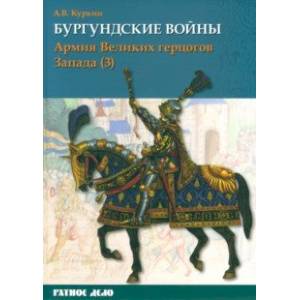Burgundian Wars. Volume 3. Part 3. The Army of the Great Dukes of the West.
Please sign in so that we can notify you about a reply
This book concludes the story about the army of the Dukes of Burgundy and marks the end of the 'Burgundian Wars' cycle in the 'Military Affairs' series. The author introduces the reader to the strategic planning of the Burgundian staff, including the analysis of forces and means, reconnaissance, and consideration of geographical space. A retrospective of the military thought of practitioners and theorists of the late Middle Ages is provided, whose treatises laid the foundation for a revolutionary overturn in the field of military affairs during the Renaissance.
In the section dedicated to tactical schemes used by medieval commanders on the battlefields, the evolution of the Burgundian disposition is examined. Influenced by the English tactical model, which had proven itself brilliantly during the Hundred Years' War, and under the pressure of infantry masses of city militias, Burgundian commanders were forced to revise traditional knightly battle schemes. Combat tasks were optimally distributed: cavalry, archers, and infantry acted in an increasingly close connection and under the cover of artillery fire. Of course, artillery had not yet become the 'god of war', and infantry - the 'queen of fields', however, their joint actions began to decide not only the fate of the 'autumn of the Middle Ages' field battles but also determine the lot of defenders of besieged fortresses. Siege warfare, the development of fortification, and the number of garrisons in the book are also given sufficient attention. In doing so, the author operates with a large corpus of sources unknown to the Russian-speaking reader.
The book is crowned with a dramatic story about a series of clashes of the army of the Burgundian Duke Charles the Bold with the forces of the Constance League, represented by military contingents of the Count of Tyrol, the Duke of Lorraine, the Swiss Confederation, and southern German cities. This protracted conflict in time and space is known to historians as the Burgundian War. Based on a vast amount of sources, the author analyzed the course of military actions and detailed the key moments of this confrontation: the battle at Hericourt, the 'dirty war' in Pays de Vaud, the battle at La Plante, the capture of Lorraine, and the defeats of Charles the Bold at Grandson and Murten. The narrative is traditionally supplemented with a rich illustrative series, colorful plates, diagrams, tables, and excerpts from documents. The book will not leave indifferent both lovers of military affairs of the late Middle Ages and specialists.
However, this book does not exhaust the theme of the military history of the Burgundian state. Ahead, readers can expect new works by the author, dedicated to the famous Burgundian knights, tournaments, orders, and heralds. The last Burgundian duke of the Valois dynasty, Charles the Bold, also deserves a separate and in-depth work, which will be published in a different format and in another series.
In the section dedicated to tactical schemes used by medieval commanders on the battlefields, the evolution of the Burgundian disposition is examined. Influenced by the English tactical model, which had proven itself brilliantly during the Hundred Years' War, and under the pressure of infantry masses of city militias, Burgundian commanders were forced to revise traditional knightly battle schemes. Combat tasks were optimally distributed: cavalry, archers, and infantry acted in an increasingly close connection and under the cover of artillery fire. Of course, artillery had not yet become the 'god of war', and infantry - the 'queen of fields', however, their joint actions began to decide not only the fate of the 'autumn of the Middle Ages' field battles but also determine the lot of defenders of besieged fortresses. Siege warfare, the development of fortification, and the number of garrisons in the book are also given sufficient attention. In doing so, the author operates with a large corpus of sources unknown to the Russian-speaking reader.
The book is crowned with a dramatic story about a series of clashes of the army of the Burgundian Duke Charles the Bold with the forces of the Constance League, represented by military contingents of the Count of Tyrol, the Duke of Lorraine, the Swiss Confederation, and southern German cities. This protracted conflict in time and space is known to historians as the Burgundian War. Based on a vast amount of sources, the author analyzed the course of military actions and detailed the key moments of this confrontation: the battle at Hericourt, the 'dirty war' in Pays de Vaud, the battle at La Plante, the capture of Lorraine, and the defeats of Charles the Bold at Grandson and Murten. The narrative is traditionally supplemented with a rich illustrative series, colorful plates, diagrams, tables, and excerpts from documents. The book will not leave indifferent both lovers of military affairs of the late Middle Ages and specialists.
However, this book does not exhaust the theme of the military history of the Burgundian state. Ahead, readers can expect new works by the author, dedicated to the famous Burgundian knights, tournaments, orders, and heralds. The last Burgundian duke of the Valois dynasty, Charles the Bold, also deserves a separate and in-depth work, which will be published in a different format and in another series.
Author:
Author:Kurkin Andrey Vladimirovich
Cover:
Cover:soft
Category:
- Category:History & Geography
- Category:Historical Literature
Dimensions:
Dimensions:26x18.5x1.3 cm
Series:
Series:Military Affairs
ISBN:
ISBN:978-5-907245-89-1
No reviews found
